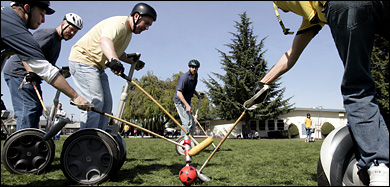No, this isn’t an April Fools Day joke:

This sport is real, it’s growing, it’s specially designed for and by wealthy dorks and I knew it was only a matter of time for something like this was invented once the Segway was unveiled to the public.
After the jump, read the NY Times article all about this “sport.” Enjoy.
Thwack! Whir!… Whir? Segway Polo Is Born
By Josh Sens
NY Times, April 1st, 2005
WHEN Alex Ko and his companions took up polo, they made some subtle changes to the sport once enjoyed by ancient Mongol warriors, who are said to have played with the severed heads of their enemies.
Mr. Ko and his friends opted for a 6-inch-diameter Nerf ball.
And instead of horses, they chose to ride Segways, the self-balancing transportation devices first developed as a short-distance alternative to the automobile.
“It’s similar to real polo,” Mr. Ko said, “but without the manure.”
He was standing in the thick grass of Ponderosa Park, a shaggy patch of green in Sunnyvale, Calif., preparing to compete in a game that replaces the thundering of hooves with the whir of battery-run machines.
On the first and third Sunday of every month, Mr. Ko, 34, a mechanical engineer from nearby Santa Clara, organizes Segway polo matches with friends and colleagues, most of whom work in the Silicon Valley, all of whom belong to the Bay Area Segway Enthusiasts Group.
Their matches have some of the trappings of traditional polo. Players wear jerseys – actually, colored T-shirts – and use mallets to knock a ball into a goal. Score is kept. And there is an umpire, although players feel free to ignore his calls.
“There are a few guys who take it seriously, but mostly this is a big goof,” said Jon Bauer, 37, of San Francisco.
This morning’s contest pitted four against four. Mr. Bauer’s team wore blue T-shirts. Mr. Ko’s team wore yellow and included Stephen G. Wozniak, one of the founders of Apple Computer and the owner of seven Segways. He is respected, if not feared, on the polo field for his aggressive play.
“My swing feels off,” Mr. Wozniak said just before the match began. He whirled his right arm in a windmill motion and said that he was operating on virtually no sleep, having stayed up at a party and then to watch a movie until 8:30 that morning.
The teams lined up on opposite sides of the field and rushed toward each other when the umpire rolled the ball between them.
At first glance, Segways could be mistaken for large push mowers, and in the early going, as the players found their rhythm on the grass, the game resembled a frenzied act of landscaping. But near the end of the first period, or chukker, in polo parlance, both teams showed signs of organization, even fleeting hints of skill.
“You should have seen us at some of the first games,” Mr. Bauer said. “We were all bunched together. Not much passing. Very little strategy.”
Like the birth of polo, placed variously in Persia or India more than 2,000 years ago, the genesis of Segway polo is hard to pin down. Mr. Ko traces his own interest in it to the fall of 2003, when a Segway polo demonstration was staged during halftime of a professional football game.
“I didn’t see it,” Mr. Ko said of the halftime show. “But it sounded pretty cool.”
Jonathan van Clute, a real estate and stock investor from Sunnyvale, said he had stumbled onto the idea even earlier, while consulting at a software company. “I brought my Segway into the office so everyone could goof around with it,” he said. “And this one guy pokes his head through the door and says, ‘Dude, two words: Segway polo.’ ”
WHATEVER the case, in April of last year, Mr. Ko and Mr. van Clute met at Ponderosa Park and began to tinker with their version of the game. Mr. Ko fashioned a mallet out of plastic pipe. They tried different types of balls before settling on a Nerf. They adopted rules from polo, water polo and bicycle polo, another contemporary offshoot. They outlawed high-sticking, or the polo equivalent of it, and agreed to run their Segways on the yellow-key setting – one of three settings on a Segway – limiting the top speed to eight miles an hour.
“We’ve never had any serious accidents,” Mr. Bauer said. “But there have been some pretty spectacular falls.”
During the match, the prospect of injury seemed to heighten whenever Mr. Wozniak entered the fray. Despite sleep deprivation, he played with zeal, charging after loose balls, leaning forward on his Segway like a ski jumper searching for extra air.
Mr. Wozniak’s opponents attributed his fearless play to his competitive gusto and his fleet of backup Segways, not unlike a traditional polo player’s string of ponies.
“Woz is the only guy who’s always cranking his Segway at top speed,” Mr. Bauer said. “I think it has something to do with the fact that he’s the least concerned with damaging his.”
Most Bay Area Segway Enthusiast Group members own only one Segway, which sell for around $5,000. Although the stated mission of the group is to promote public acceptance of the machines, many members spend more time playing polo on them than proselytizing for them. Mr. Bauer, in fact, who lives in San Francisco, where Segways are prohibited on sidewalks, said that his was used only for the Sunday matches.
“I used to ride mine more, but part of me got tired of dealing with the negativity,” Mr. Bauer said. “You can’t use them on the sidewalk, and if you do, people are yelling at you. Or they’re thinking of you as a yuppie, which in a sense you are.”
This was not the dream of Dean Kamen, inventor of the Segway Human Transporter, when he rolled out the first model in 2001. Easy to ride and ecofriendly, the Segway was hailed as an innovation that would revolutionize the modern city.
Just how much has changed is perhaps evident in the transportation used by players to get to their polo matches. Most drive. Mr. Wozniak often shows up in his Hummer, hauling four Segways in the back.
If the Segway has yet to transform urban living, it has at least altered recreational sport, if only slightly. It is fitting that it has happened in the Silicon Valley, a region renowned for finding innovative uses for technology. Recently, Mr. Ko said, a group of Segway enthusiasts in Southern California has taken up Segway polo. But his hopes for an intrastate rivalry have not materialized.
“I don’t think they’re quite that organized down there yet,” Mr. Ko said.
At Ponderosa Park, meantime, the match wore on. In the third chukker, Stuart Moore, 39, of San Jose, notched an impressive goal, moments before taking an impressive spill when his Segway bumped wheels with Mr. Wozniak’s. Mr. Moore hurtled headlong onto the grass; his Segway rolled on poignantly, like a riderless horse.
The score was tied in the fourth and final chukker when Mr. Wozniak shot at goal and raised his arms in triumph. The umpire, Chris Knight, 16, of San Francisco, ruled that it went wide. But Mr. Wozniak and his teammates paid no heed, exchanging high-fives with their mallets. The goal stood.
Other things happened. A player’s shin was bruised and another took a glancing blow to his helmet. The blue squad tried a last-ditch comeback. But as time expired, the score was 7 to 5, in favor of the yellow team. The players left the field, laughing and giddy. They were still full of energy, but their Segway batteries were running low.

